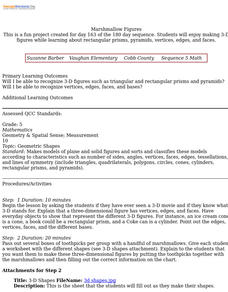PBS
Frame Yourself: Area and Perimeter
Elementary schoolers are arranged in pairs and view the video Math Works: Measurement: The Difference Between Perimeter and Area. They discuss any prior knowledge they have of the term perimeter and then brainstorm together what the...
National Gallery of Canada
Lumps, Bumps, Gritty, and Soft!
Texture can really add to a work of art. Explore texture through observation and practice. Learners view and discuss works of art by M.C. Escher. They then create their own texture samplers with six different materials.
National Gallery of Canada
My Upside-Down World!
M.C. Escher is famous for creating optical illusions. Examine this effect in several of his works and discuss the techniques involved. Inspired by the discussion, learners create an imaginary 3-D world inside of a box using various...
Curated OER
Valentine's Day Fun
Young scholars choose various shapes and colors to create a Valentine's 'person'. In this Valentine's Day lesson, students design collages, make prints and mosaic pictures. More advanced young scholars create a Tessellation using...
Curated OER
Marshmallow Figures
Students enjoy making 3-D figures while learning about rectangular prisms, pyramids, vertices, edges, and faces. After a lecture/demo, students use marshmallows, toothpicks and a worksheet imbedded in this lesson to create 3 dimensional...
Curated OER
Beauty: Patterns in Nature
Young scholars explore the patterns of nature. In this interdisciplinary lesson plan, students examine beauty in nature and participate in a hands-on simulation that demonstrates how human preferences for beauty have led to an increased...
Curated OER
Measuring the Area of Polygons
Fourth graders use pattern blocks to explore areas of polygons. They explain that the answers to the area of the same polygon vary according to the units of measurement used. They visualize how different units of measurement can be used...
Other popular searches
- Visual Art Tessellations
- Tessellation Worksheets
- Math Tessellations
- Geometry Tessellations
- Drawing Tessellations
- Making Tessellations
- Tessellation M. C. Escher
- Art Tessellation
- Tessellation Art Projects
- Tessellations Art
- Tessellation Second Grade
- Tessellations Hexagon








